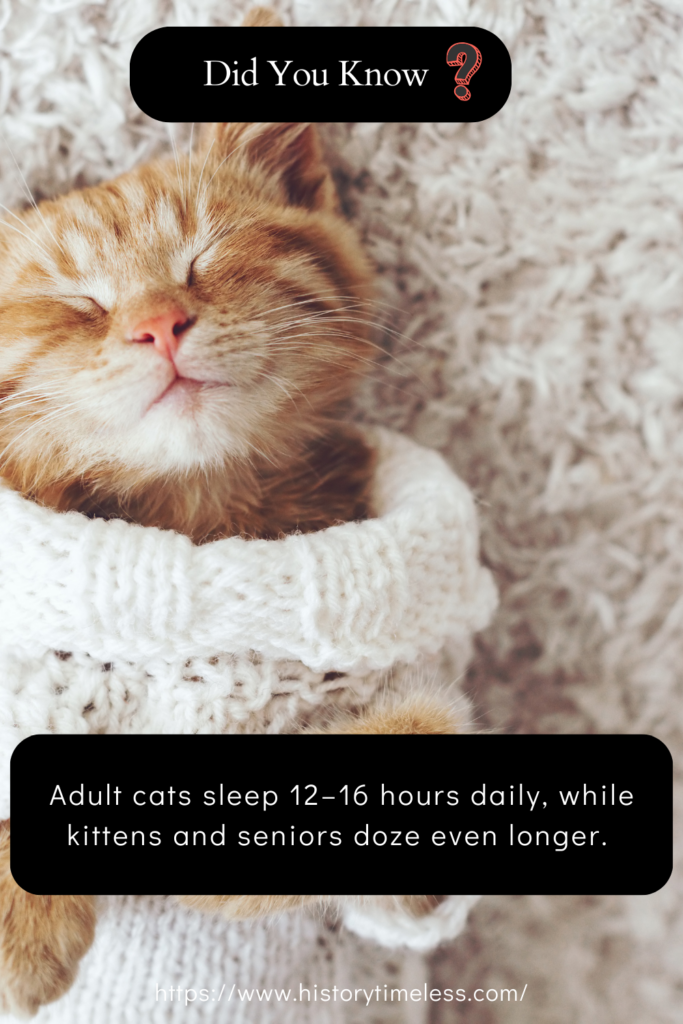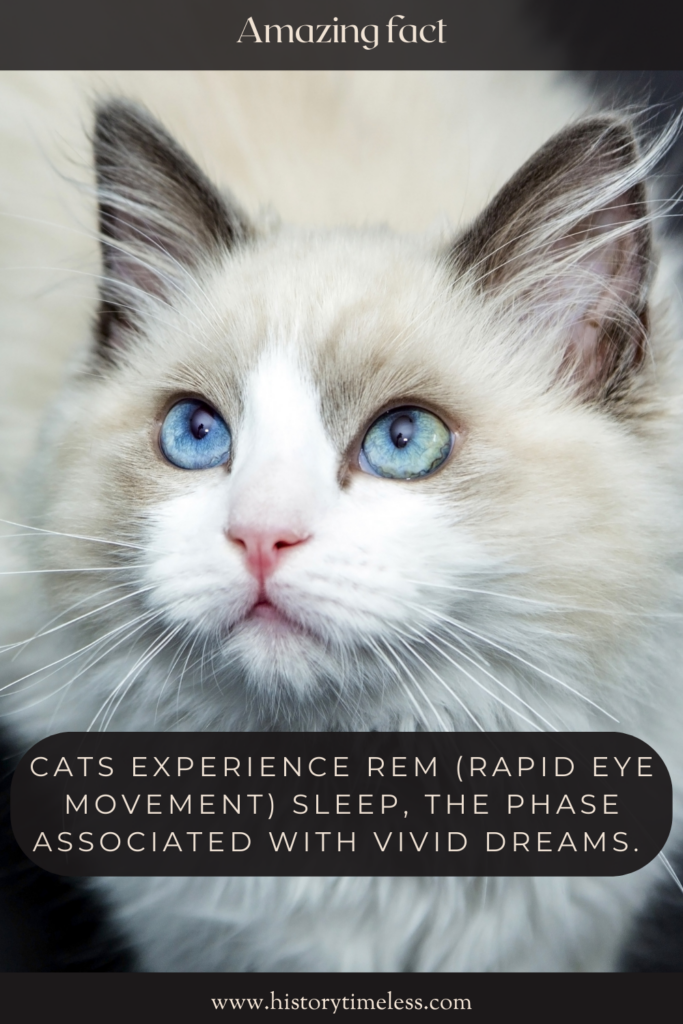Cats are fascinating creatures, blending mystery, agility, and charm into one fluffy package. Whether they’re ruling the internet or your living room, their quirks never fail to captivate.
From their ancient history to their bizarre behaviors, there’s always something new to learn about our feline friends. Here are 26 surprising facts about cats that will make you see them in a whole new light!
1. Cats Have a Specialized “Silent Meow” Just for Humans
Cats rarely meow at other cats—instead, they reserve this vocalization almost exclusively for humans. Researchers believe they’ve developed a range of meows, purrs, and chirps to communicate with us, almost like a secret language.
The “silent meow,” where a cat opens its mouth but no sound comes out, is particularly intriguing. It’s thought to be a super-effective attention-grabber, playing on human instincts to respond to subtle cues.
2. A Cat’s Whiskers Are Built-In Measuring Tapes
Those long, sensitive whiskers aren’t just for show—they’re precision tools. A cat’s whiskers are roughly as wide as its body, helping them gauge whether they can fit through tight spaces.
They also detect air currents, aiding in navigation (even in total darkness). Cutting a cat’s whiskers disorients them, so never trim these vital sensory hairs!
3. Cats Spend 70% of Their Lives Asleep
If you’ve ever wondered why your cat seems to nap all day, here’s the answer: Adult cats sleep 12–16 hours daily, while kittens and seniors doze even longer.

This habit stems from their evolutionary role as predators—conserving energy for short, intense bursts of hunting.
Their sleep cycles include light dozing (where they’re still alert) and deep REM sleep, complete with twitching paws and dreamy whisker movements.
4. Your Cat’s Nose Print Is Unique, Like a Fingerprint
Just as human fingerprints are one-of-a-kind, every cat’s nose has a distinct pattern of bumps and ridges. No two are alike! Some animal shelters even use nose prints for identification.
The rough texture also helps enhance their sense of smell, which is 14 times stronger than a human’s. Next time your cat boops you, remember: That nose is their personal ID card.
5. Cats Walk Like Camels and Giraffes
Watch closely—cats move both right legs first, then both left legs, a gait called “pacing” shared by camels and giraffes. Most other four-legged animals alternate sides.
This unique walk contributes to their graceful, stealthy movements. It also minimizes noise and leaves fewer tracks, making them expert stalkers in the wild (or when sneaking up on your unsuspecting ankles).
6. Ancient Egyptians Mourned Cats by Shaving Their Eyebrows
In ancient Egypt, cats were revered as sacred beings. When a family’s cat died, owners shaved their eyebrows as a sign of grief and held elaborate funerals.
Harming a cat (even accidentally) was punishable by death. Egyptians believed cats carried divine energy, which explains why they were often mummified alongside pharaohs. Talk about VIP treatment!
7. Cats Can’t Taste Sweetness
Unlike dogs (and humans), cats lack taste receptors for sweetness due to a genetic mutation. Their diet-focused evolution as carnivores made sugar detection unnecessary.
So, while your cat might curiously sniff your ice cream, they’re likely more interested in the fat content than the flavor. This also explains why they’re unimpressed by fruits or desserts—give them meat or fish instead!
8. Cats Have a Built-In GPS in Their Whiskers
Cats possess an extraordinary navigation system thanks to their whiskers, which act like built-in compasses. These specialized hairs, called vibrissae, detect subtle changes in air pressure and vibrations, helping cats map their surroundings—even in complete darkness.
Outdoor cats use them to find their way home over long distances, while indoor cats rely on them to avoid bumping into furniture.
This natural GPS is so precise that blind cats can often navigate rooms effortlessly using just their whiskers!
9. A Cat’s Purr Has Healing Superpowers
That soothing rumble isn’t just comforting—it’s therapeutic! Cats purr at frequencies between 20–150 Hz, a range scientifically proven to promote bone density, reduce pain, and even speed up healing.
Studies suggest the vibrations may help repair muscles and tendons, explaining why cats often purr when injured.
Bonus: Snuggling a purring cat can lower human stress levels and blood pressure, making them fuzzy little healers.
10. Cats Sweat Through Their Paw Pads
Unlike humans, cats don’t sweat all over—they only release moisture through their tiny paw pads. You might spot damp paw prints on hot days!
When temperatures soar, they also lick their fur to cool down via evaporation (like a built-in AC system). But since this isn’t super efficient, cats prefer lounging in shade or on cool tiles to beat the heat.
11. The World’s Richest Cat Had a $13 Million Fortune
A black cat named Blackie inherited a whopping $13 million from his wealthy owner, Ben Rea, in 1988—making him the richest cat in history.
Rea left his fortune to Blackie instead of his human family, specifying the money be used for the cat’s care (and donating the rest to animal charities). While Blackie lived a lavish life, most cats today settle for extra treats and cardboard boxes.
12. Cats “Blep” to Taste the Air
That adorable moment when a cat’s tongue sticks out (a blep) isn’t just for cuteness—it’s science! Cats have an extra scent organ called the Jacobson’s organ on the roof of their mouths.
When they catch an intriguing smell, they might open their mouths slightly to “taste” the air, transferring scents to this organ for analysis. It’s like their version of wine-tasting!
13. Your Cat’s Grooming Ritual Is a Survival Tactic
When your cat licks itself obsessively, it’s not just about cleanliness—it’s a survival instinct. Grooming removes strong scents that could attract predators or alert prey.
It also spreads natural oils to waterproof their fur and regulates body temperature. Bonus: The barbed texture of their tongue acts like a built-in comb, detangling fur and removing loose hair (which is why hairballs happen).
14. Cats Dream Just Like Humans
Ever noticed your cat twitching or “running” in their sleep? They’re likely dreaming! Cats experience REM (rapid eye movement) sleep, the phase associated with vivid dreams.

Studies suggest they replay daytime activities—like chasing toys or birds—in their slumber. Kittens dream more often than adults, possibly practicing their pouncing skills in dreamland. Sweet dreams, little hunters!
15. Cats Have a Third Eyelid for Extra Protection
Hidden in the inner corner of your cat’s eyes is a nictitating membrane – a translucent third eyelid that horizontally sweeps across the eye.
This evolutionary marvel protects their eyes from dust and injury while hunting, helps keep them moist, and even contains a small amount of lymph tissue to fight infections. You might spot it when your cat is very relaxed or slightly dehydrated.
16. A Cat’s Ear Contains 32 Muscles for Precision Hearing
Those adorable swiveling ears aren’t just cute – they’re biological marvels! Each ear can rotate 180 degrees independently thanks to 32 muscles (compared to humans’ 6).
This allows cats to pinpoint sounds within 3 inches from up to 3 feet away, and hear frequencies up to 64,000 Hz (we max out at 20,000 Hz). Their ears also help with balance – another reason they always land on their feet.
17. Cats Walk on Their Tiptoes for Stealth
Unlike humans who walk flat-footed, cats are “digitigrade” walkers – they move on their toes with their heels permanently raised. This gives them that distinctive graceful gait and allows for silent stalking.
Their walking pattern (right front and left back legs moving together) creates minimal noise and leaves confusing tracks – perfect for ambushing prey or sneaking up on unsuspecting owners at 3 AM.
18. Some Cats Are Born with Extra Toes (Hemingway Cats)
About 40-50% of cats in Key West, Florida have polydactyly – extra toes that make their paws look like mittens. This genetic quirk was common in ship’s cats (the extra digits helped with balance at sea).
It was famously loved by Ernest Hemingway, whose six-toed cat’s descendants still roam his Key West home. These “Hemingway cats” can have up to 7 toes per paw!
19. Cats Can Make Over 100 Different Vocal Sounds
While dogs have about 10 vocal sounds, cats have an impressive repertoire of 100+ sounds they use to communicate. These include:
- The solicitation purr (a purr mixed with a meow to demand food)
- Chirps and chatters when watching birds
- Trills as greetings
- Growls and hisses for warnings
- And that special 3 AM yowl just to keep you on your toes
20. A Cat’s Brain is 90% Similar to Humans
Structurally, cat brains share 90% similarity with ours, including nearly identical regions for emotions. They experience:
- Short-term and long-term memory
- Complex problem-solving skills
- Emotional responses like affection and jealousy
- The ability to learn through observation (like opening doors)
This explains why they can be so expressive and sometimes downright manipulative when they want something!
21. Cats Rub You to Claim You as Their Territory
When your cat head-butts or rubs against you, they’re not just showing affection – they’re marking you with scent glands in their cheeks, chin, and tail base.
These pheromones signal to other cats that you’re “theirs.” It’s the ultimate compliment in cat language – they’re basically putting their name tag on you! This behavior is called bunting and releases feel-good endorphins for both cat and human.
22. Cats Have a Secret Communication Tool in Their Tails
A cat’s tail is like a mood antenna with its own language:
- Straight up = Happy and confident
- Puffed up = Scared or aggressive
- Slow swish = Focused (possibly about to pounce)
- Wrapped around you = Cat hug
- Twitching tip = Mild irritation The tail also helps with balance – cats without tails (like Manx cats) compensate with stronger back legs!
23. Cats Can Drink Seawater in Emergencies
Unlike humans, cats’ kidneys are so efficient they can filter out salt and extract hydration from seawater if stranded. This evolutionary adaptation helped their ancestors survive in arid environments.
However, this doesn’t mean you should offer saltwater – fresh water is always best for their long-term health. This superpower explains why cats historically thrived as ship’s companions.
24. Your Cat’s “Love Bites” Come From Kittenhood
Those gentle nibbles during petting sessions are called “love bites” and originate from kitten behavior. When nursing, kittens knead and gently bite to stimulate milk flow.
Adult cats retain this comforting behavior when feeling especially content. It’s their way of saying “you’re family” – though sometimes they forget their teeth are sharper now!
25. Cats See Better Than Humans in Near-Darkness
While cats can’t see in complete darkness, they only need 1/6th the light humans do thanks to:
- A reflective layer (tapetum lucidum) that bounces light back through retina
- More rod cells for low-light vision
- Vertical slit pupils that adjust faster Their night vision comes at a cost – they see colors less vividly and are slightly nearsighted (great for hunting, bad for reading street signs).
26. Some Cats Develop “Wool Sucking” Behavior
Certain cats (especially Siamese and other Oriental breeds) suck on wool blankets, clothing, or even human hair. This comforting behavior stems from being weaned too early as kittens.
It’s harmless unless they swallow fibers, in which case provide safe alternatives like plush toys. Some experts believe it may also be linked to a genetic predisposition from their wild ancestors who sucked prey fur for moisture.
Absorb more exciting tidbits:
25 Amazing Facts About World You Should Know
10 Interesting Facts You’ve Never Heard Before!
20+ Insane Facts About Animals That Defy Belief!
15+ Interesting World Facts: Say ‘Wow’ to These Discoveries!





